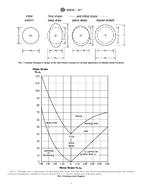1.1 This test method covers guidelines for acoustic emission (AE) examinations of new and in-service aboveground storage tanks of the type used for storage of liquids.
1.2 This test method will detect acoustic emission in areas of sensor coverage that are stressed during the course of the examination. For flat-bottom tanks these areas will generally include the sidewalls (and roof if pressure is applied above the liquid level). The examination may not detect flaws on the bottom of flat-bottom tanks unless sensors are located on the bottom.
1.3 This test method may require that the tank experience a load that is greater than that encountered in normal use. The normal contents of the tank can usually be used for applying this load.
1.4 This test method is not valid for tanks that will be operated at a pressure greater than the examination pressure.
1.5 It is not necessary to drain or clean the tank before performing this examination.
1.6 This test method applies to tanks made of carbon steel, stainless steel, aluminum and other metals.
1.7 This test method may also detect defects in tank linings (for example, high-bulk, phenolics and other brittle materials).
1.8 AE measurements are used to detect and localize emission sources. Other NDT methods may be used to confirm the nature and significance of the AE indications (s). Procedures for other NDT techniques are beyond the scope of this test method.
1.9 Examination liquid must be above its freezing temperature and below its boiling temperature.
1.10 Superimposed internal or external pressures must not exceed design pressure.
1.11 Leaks may be found during the course of this examination but their detection is not the intention of this test method.
1.12 The values stated in inch-pound units are to be regarded as the standard. The SI units given in parentheses are for information only.
1.13 This standard does not purport to address all of the safety concerns, if any, associated with its use. It is the responsibility of the user of this standard to establish appropriate safety and health practices and determine the applicability of regulatory limitations prior to use. Specific precautionary statements are given in Section 8.
Product Details
- Published:
- 07/10/2002
- Number of Pages:
- 11
- File Size:
- 1 file , 110 KB
- Redline File Size:
- 2 files , 200 KB

